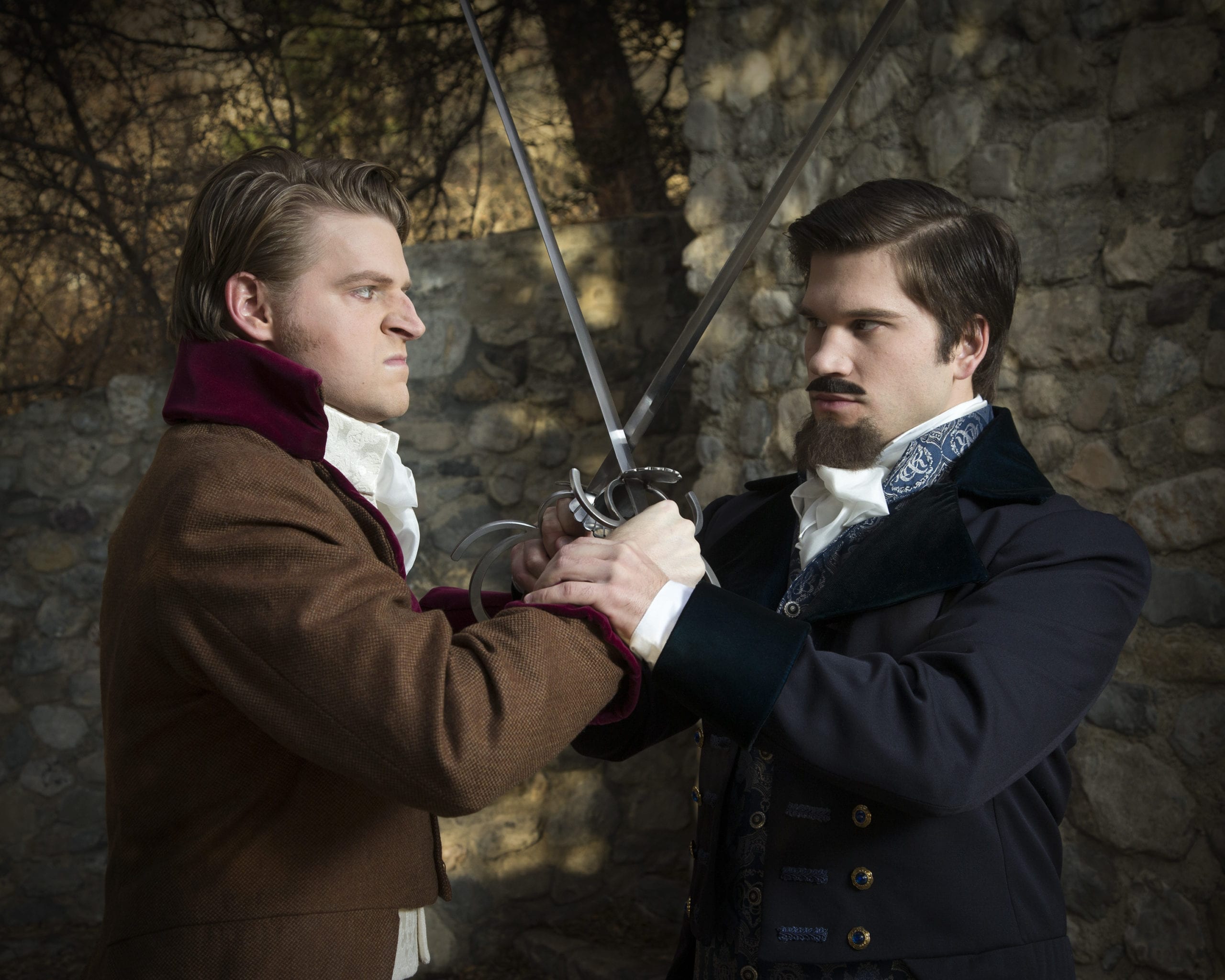PROVO — When a conspiracy puts him unjustly behind bars, Edmund Dantes wants revenge.
The years in prison have allowed Edmund’s anger to smolder, and once he breaks free, Edmund is determined to make his enemies pay for what they have done to him. He adopts a new identity as the sophisticated Count of Monte Cristo, and works to ruin his enemies’ lives as they ruined his. A musical adaptation (created by composer Frank Wildhorn and lyricist/librettist Jack Murphy) of Alexandre Dumas‘s classic novel is on stage in its must-see American premiere at BYU.
Director Tim Threlfall handles this challenging show so well that, in the end, every scene is presented with clarity of purpose. Abrupt changes in tone, such as the entrance of the pirates or the story moving to Paris, were executed naturally and smoothly. Threlfall was also a master of dramatic tension, whether it was in the reunion between Edmund or Mercedes, or a party interrupted by an arrest. Most important, though, was Threlfall’s focus on the psychological changes in Edmund’s story, especially as prison hardens him and then, later, as he feels the spiritual emptiness that accompanies revenge. With all the spectacle of the show, Threlfall never forgot that at the heart of The Count of Monte Cristo is the tale of a man struggling with his past and his own humanity.
In the title role, Preston Yates delivered an unforgettable, moving performance. Yates’s powerful voice easily handled the vocal challenges and emotion of Wildhorn’s score in songs like “Another Day,” “The Man I Used to Be,” and “Hell to Your Doorstep.” Moreover, Yates’s masculine charisma makes him a natural for a role that requires him (at various times) to be a prisoner, a fighter, a sailor, a schemer, and a gentleman. Yates has shown yet again that he has the ability and talent to successfully play some of the most vocally demanding roles in musical theatre. Furthermore, Yates had broken his foot the previous evening. Yet, his flawless performance shows that he can handle physical challenges that many other actors cannot.
Shae Robins, as Edmund’s fiancée Mercedes, is a sweet ingénue. The character doesn’t do much for most of the play, but Robins takes advantage of the character’s many songs to provide depth to the character. Robins’s best songs were “When the World Was Mine” and “All This Time,” both of which provided her with lyrics that allowed Robins to explore her character’s profoundly penetrating emotions and anxieties. However, my favorite female cast member was Lauren Hughes as Louisa Vampa, the leader of a band of pirates. Her raucous rendition of “Truth or Dare” was one of the most thrilling parts of the night, especially when accompanied by Nathan Balser‘s choreography. Hughes also contributed comic relief to some scenes, such as the catacomb scene, which contributed to the wide variety of moods within the play.

Left to right: Cameron Smith as Baron Danglars, Taylor Morris as Fernand Mondego, Matthew Krantz as Gerard De’Villefort.
The trio of antagonists who conspire against Edmund were played by Taylor Morris (as Fernand Mondego), Cameron Smith (as Baron Danglars), and Matthew Krantz (as Gerard De’Villefort). All three were evil and malicious, but in unique ways. Morris showed clearly that his character was driven by lust for Mercedes, and the way he feigned tenderness during “Is There Any News?” made his eventual marriage to Mercedes plausible. Smith showed that Danglars was motivated by money, and his greedy nature was obvious as he was plotting in “Too Much Is Not Enough.” Krantz’s character’s unlimited thirst for power was believable in his first scene, and it made his downfall in the second act seem inevitable. As enjoyable as these three men were, though, it was their moments together on stage that were my favorite, such as the energetic dance in “Hell to Your Doorstep” and in “Too Much Is Not Enough.” The interplay of the characters’ unique characteristics with their common villainy was one of the many delights of the evening.

Left to right: Cameron Smith as Baron Danglars, Taylor Morris as Fernand Mondego, Matthew Krantz as Gerard De’Villefort, Preston Yates as Edmund Dates, Shae Robins as Mercedes, Cayel Tregeagle as Albert, Cassie Austin as Valentine Villefort.
The Count of Monte Cristo is a technical wonder on the stage. Chief among the technical aspects is Jeff Carter’s sound design, which sounded crisp and realistic (especially when Edmund was being whipped in prison). Carter also was able to blend the actors’ amplified voices with the massive orchestra (under the direction of Christian Smith) to create a beautiful sound that emphasized the score’s strengths—a difficult task for a score that includes orchestral rock and traditional musical theatre sounds. Another commendable aspect of the production was Lara Beene‘s costumes, which did more to convey the historical time period of the play than anything other aspect of the play. The sheer diversity of Beene’s costumes is staggering and included sophisticated waistcoats, sumptuous ball gowns, tattered prison outfits, pirate garb, military uniforms, carnival costumes, and more. Some theatre companies don’t have this much variety in their costumes in the course of an entire season.
It’s also important to mention Daniel Fine’s projections, which served as the majority of the scenery in this play. Fine avoided the static look of many onstage projections by adding subtle animations, such as changing phases of the moon, or growing foliage. He also included animated transitions from one projection to another—a wonderful touch that helped scenes flow smoothly together. However, it was a frustrating aspect that the downstage right projections were constantly out of focus. The projections also seemed distorted at times, especially when they showed the moon, which always looked like a flattened oval instead of a circle.
The play’s biggest flaw actually has nothing to do with this show at all. While watching The Count of Monte Cristo, it is difficult not to think of Les Misérables. Both musicals follow a central male character who has spent time in jail for years, and both shows take place in post-Napoleonic France. However, the similarities between the shows stop there. Monte Cristo is its own work of art, and the distinctive score, coupled with the completely different set of themes, ensures that Monte Cristo is certainly not a retread of Les Misérables, despite some superficial similarities.
There were also an assortment of minor issues with the play, such as the use of clichés in the writing. (“History is a story told by those who win the fight,” or “Revenge is a dish best served cold.”) I was also confused when Edmund spontaneously offered a massive fortune to Jacopo (played by James Bounous), and even more puzzled when Jacopo turned down the huge sum. Also, it was annoying that Abbé Faria (played by Brian Clark) seemed to have far too much energy during “When We Are Kings,” despite having been mortally wounded. Finally, I found the 21st century hair on some of the actors—particularly Cameron Smith’s—distracted from the effort that other designers put into recreating early 19th century France.
As I left the theatre I felt a profound gratitude towards the creators, the cast, and the crew of The Count of Monte Cristo. The production is a wonderful contribution to the musical theatre canon, and I believe that it is some of Wildhorn’s greatest work. The story’s emphasis on redemption and forgiveness are universally appealing, and when coupled with the excellent score the result is a show that should be on every Utah theatre fan’s calendar.








